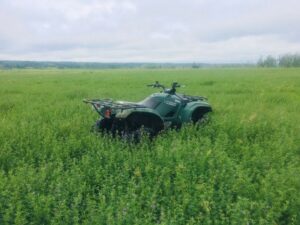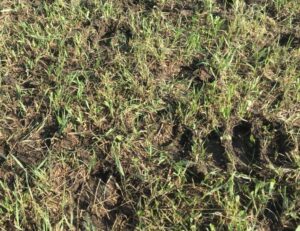The Seed is Falling – Aerial Seeding Alfalfa was Worth a Shot for One Operation
Remarque : cette page web n’est actuellement disponible qu’en anglais.
Aerial seeding crops is not a new idea for many farmers, particularly those in flood-prone regions. However, most producers that are experienced with seeding by plane typically plant canola or other annual cash crops, not forages. While there have been a few examples where producers or organizations have experimented with aerial seeding forages, results have been variable, due in part to weather, timing of activities, and seedbed contact.
Arron Nerbas, of Nerbas Brothers Angus, was trying to figure out a way to rejuvenate some of their farm’s old forage stands that were located in the floodplain of the Assiniboine River Valley. These one-time hay fields became subjected to extended periods of flooding for many years, with floodwaters lasting for six to eight weeks. “What came back was primarily quack grass and reed canary, not productive forage species,” Nerbas explains. “In past years we would spray it out then seed a companion oat crop under-seeded to forage,” Nerbas says. “Because of the flooding, we didn’t want to take the risk of spending a lot of money.” In an effort to come up with a solution that was cost effective and flexible, they turned an eye to the sky and decided to investigate aerial seeding. “We thought instead of completely re-establishing a forage stand, why don’t we try and fly out alfalfa and see if that would work.”
The Nerbas family contracted a traditional spray plane operator that placed seed into the tank area where chemical or fertilizer would typically go. “Instead of being distributed through a nozzle, there’s a slide gate at the bottom where a manifold fits under the plane. The seeds spread out, blowing out by force,” Nerbas describes. They flew over the field, planting inoculated alfalfa at a rate of approximately 10 pounds per acre.

The first year they seeded 400 acres, and the following year they planted approximately 300 acres, both times flying during the third week of May. “We wanted to wait until spring and work around the applicator’s busy season,” Nerbas explained. “We had average moisture at time of seeding and both times we had good rain two to three weeks following seeding,” Nerbas says, and attributes the success of the project to those timely rains. While prices will vary by farm, suppliers, and area, Nerbas estimates he was able to improve his forage stand with an investment of around $25/acre for seed and application costs.
Many farmers who aerial or broadcast seed try to improve seed-to-soil contact by harrowing, however Nerbas likes to let his cattle do that job for him. After seeding, they split the field into parcels ranging in size from 100 acres to 150 acres, and immediately grazed a herd of 250 pairs for about a week to allow the cattle to punch the seeds in with their hooves. They followed up with additional grazing that season about thirty days later but Nerbas adds management should be tailored according to the year and the producer’s goals. “In hindsight we probably shouldn’t have grazed again for the rest of the year if we wanted the alfalfa to thrive sooner. It doesn’t really look like it hurt it, but it did delay it,” he adds.
While this may not be a mainstream practice, there are some key points to remember when aerial seeding forages:
- Species selection: consider the seed size and weight, which are important factors for aerial calibration and metering. In Nerbas’ case, legumes made the most sense for providing an economical boost in forage production. Also, alfalfa is a small, dense, uniform seed, that flows easily in the seed tank and is less likely to bridge.
- Patience: “To rejuvenate forages this way, you have to be prepared to be patient,” Nerbas says. In the first year, he admits that the alfalfa seedlings looked spindly and unlikely to amount to much compared to a traditional break-and-re-seed experience, but the idea, and the economics, paid off in the end.
- Know your costs: sourcing quality seed that is economical, as well as finding a willing contractor able to seed during a reasonable time frame are key elements producers need to factor in.
- Seed to soil contact: have a plan in place that includes any fencing or stock water infrastructure necessary so that grazing animals can be moved into the area for necessary hoof action when the time is right.

The Nerbas family is continuing to experiment with aerial seeding and have expanded beyond their flood-prone land and are now testing the idea on their top lands as well. They flew some extra alfalfa seed onto these drier, sandy areas and found some promising results. They are also potentially considering trying other legume species.
Nerbas is careful to point out that his experience with aerial seeding may not be the same for everyone. “The stars aligned for us for it to work that well,” Nerbas says. Flexibility, out-of-the-box thinking, and persistence helped create a successful outcome too.
Learn more:
- Hooves not Harrows – Harnessing Cow Power to Rejuvenate Forages (BCRC Blog Post)
- Rejuvenation of Hay and Pasture (BCRC Topic Page)
Click here to subscribe to the BCRC Blog and receive email notifications when new content is posted.
The sharing or reprinting of BCRC Blog articles is welcome and encouraged. Please provide acknowledgement to the Beef Cattle Research Council, list the website address, www.BeefResearch.ca, and let us know you chose to share the article by emailing us at info@beefresearch.ca.
We welcome your questions, comments and suggestions. Contact us directly or generate public discussion by posting your thoughts below.